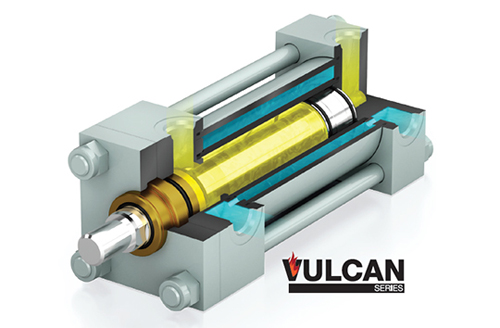Excessive heat is the bane of many hydraulic systems, as it can degrade fluids and components and hurt machine performance and uptime. That certainly holds for hydraulic cylinders operating in high-temperature environments, according to engineers at Milwaukee Cylinder, based in Cudahy, Wis.
In a presentation at last week’s 2016 Fluid Power Technology Conference in Milwaukee, hosted by Fluid Power World, the company’s Engineering Leader Douglas Lacina outlined the sources of heat in and on cylinders and explained how to mitigate the harmful effects.
For instance, inefficient flow through tight restrictions and high-speed mechanical operations cause friction that generates heat. And even well-designed circuits must sometimes mount cylinders in mills and foundries and near heat sources like furnaces, boilers and engines. According to Lacina, engineers should always ensure systems are designed to accommodate normal heat loads from the system and environment. That includes installing properly sized oil coolers and reservoirs that dissipate heat and keep hydraulics temperatures down.
In addition, he said, it’s critical to properly maintain a system. Contamination in the fluid can increase friction and speed oil breakdown and loss of lubricity. Thus, maintaining filters and periodically testing fluid quality is essential. Users should also operate hydraulic systems within rated design parameters. Pushing machines beyond recommended limits, say by running them at higher pressures or speeds, will tend to raise equipment and circuit temperatures.
Unfortunately, excessive temperatures damage seals. Common seals are generally designed to operate below 180° F. Beyond that, the material’s resistance to friction, abrasion and tearing drops off, which may lead to seal failure. High-temperature operation also hurts the viscosity, heat capacity and corrosion resistance of typical hydraulic oils. That, in turn, leads to higher friction, additional contamination and more-frequent breakdowns.
What can be done to handle the heat? Lacina makes several recommendations. Simple options are to move the cylinder away from the heat source, install walls or barriers to protect the cylinder, insulate the heat source or hydraulic system, and add cooling ventilation.
If that’s not possible or effective, next consider the seal materials. Standard seal materials like nitrile and polyurethane are generally rated in the 180° to 200° F range. But ethylene propylene and Viton seals, for example, are available for operation to 350° F, and polytetrafluoroethylene (PTFE) seals are made to withstand temperatures to 500° F.
If changing the seals or fluids aren’t enough, engineers should consider water-cooled hydraulic cylinders. Such designs pass cooling fluid through a cylinder and absorb and remove ambient heat energy, keeping cylinder temperature within recommended limits and protecting seals and other components.
Milwaukee Cylinder’s Vulcan Series of water-cooled cylinders, for example, come in several versions. One includes a water jacket between the cylinder barrel ID and OD. Water can also be applied to the rod bearing/bushing for direct seal cooling. This design can be specified when the rod sees high temperatures, such as when extending into a furnace.
In any case, users should carefully control cylinder movements in high-temperature settings. If at all possible, the rod should remain retracted and only extend for short periods, so it is protected inside the water-cooled cylinder. Reflective boots can be added to help minimize radiant heat absorbed by the rod.
In so-called water-cooled hydraulic cylinders, “water” may not necessarily be the recommended coolant. Users should select the appropriate fluid based on corrosion-resistance and heat-capacity properties. If in doubt, application engineers at Milwaukee Cylinder are experienced in sizing these cylinders based on heat loads, duty cycle, coolant temperature and flow, and many other factors.
Milwaukee Cylinder
www.milwaukeecylinder.com
Filed Under: Cylinders & Actuators, News
